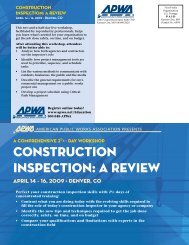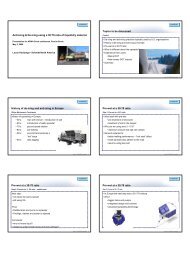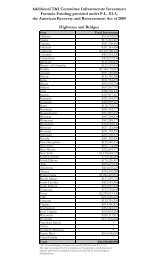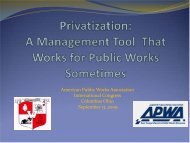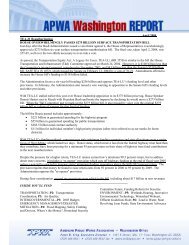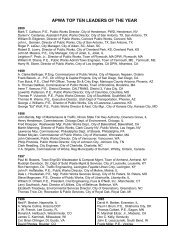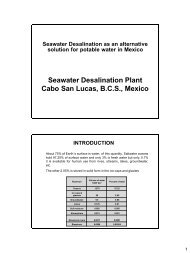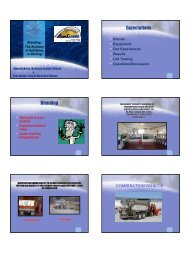Urban Forestry Best Management Practices for Public Works
Urban Forestry Best Management Practices for Public Works
Urban Forestry Best Management Practices for Public Works
- No tags were found...
Create successful ePaper yourself
Turn your PDF publications into a flip-book with our unique Google optimized e-Paper software.
<strong>Urban</strong> <strong>Forestry</strong> <strong>Best</strong> <strong>Management</strong> <strong>Practices</strong> <strong>for</strong> <strong>Public</strong> <strong>Works</strong> ManagersStaffing
<strong>Urban</strong> <strong>Forestry</strong> <strong>Best</strong> <strong>Management</strong> <strong>Practices</strong> <strong>for</strong> <strong>Public</strong> <strong>Works</strong> ManagersStaffingContentsIntroduction ................................................. 1What is an Arborist? .................................... 2Staffing Complement ................................... 3"In-House or Contractual" Pros and Cons ... 6Staff Training and Development ................... 9For More In<strong>for</strong>mation ................................ 11Thank You .................................................. 12I
<strong>Urban</strong> <strong>Forestry</strong> <strong>Best</strong> <strong>Management</strong> <strong>Practices</strong> <strong>for</strong> <strong>Public</strong> <strong>Works</strong> ManagersIntroductionWithin our communities, trees are oneof the most valuable public assets. Theyare unique from other assets that publicworks departments manage in that theyare living, growing organisms and can havepotentially very long service lives. The careand management of this valuable resourcerequires specialized, professional expertiseand a unique set of work skills.In this best management practices guide,in<strong>for</strong>mation will be provided to describethe staffing recommended <strong>for</strong> operating anefficient and effective urban <strong>for</strong>estry plantingand maintenance program within a publicworks department.1
<strong>Urban</strong> <strong>Forestry</strong> <strong>Best</strong> <strong>Management</strong> <strong>Practices</strong> <strong>for</strong> <strong>Public</strong> <strong>Works</strong> Managers: StaffingWhat is an Arborist?Be<strong>for</strong>e describing aspects of staffing, suchas the types and numbers of positions,qualifications, and pros and cons of in-houseand contractual services, it is important toknow how urban <strong>for</strong>estry staffing is differentfrom other positions in a public worksdepartment.The management of individual, landscapetrees is called “arboriculture,” and staff whoparticipate in the management of thesetrees are called “arborists.” Arborists aremen and women who make a career ofcaring <strong>for</strong> the urban <strong>for</strong>est. Their work isphysically demanding, often dangerous, andintellectually challenging. As science andexperience reveal new in<strong>for</strong>mation abouttree biology, physiology, maintenance andplanting, arborists’ need <strong>for</strong> education neverstops.Like the arborist, the “urban <strong>for</strong>est manager”is a professional experienced in all aspectsof arboriculture in the public arena. Theurban <strong>for</strong>est manager is dedicated to theadministration of the tree managementprogram to achieve the goals of a safe public<strong>for</strong>est that maximizes tree benefits <strong>for</strong> thecommunity in the long term. This broadmanagerial view and responsibilities enablethe professional urban <strong>for</strong>ester to help publicworks staff, elected officials, and citizensmake wise decisions and get the most <strong>for</strong>their investment in trees.Just because someone is experienced withthe use of a chainsaw or a shovel does notmake him or her automatically qualified toprune or plant trees. Specific education andtraining, and a comprehensive understandingof trees, site conditions, and long-termmanagement issues is required to properlytake care of and plant public trees.2
<strong>Urban</strong> <strong>Forestry</strong> <strong>Best</strong> <strong>Management</strong> <strong>Practices</strong> <strong>for</strong> <strong>Public</strong> <strong>Works</strong> Managers: StaffingStaffing ComplementGenerally, an urban <strong>for</strong>estry program hasboth supervision and operational employeeswho are supported by administrative andother management employees within thepublic works department.As reported in a 1994 report titled “MunicipalTree <strong>Management</strong> in the United States,”on average, municipalities have six (6)daily employees in their municipal treemanagement programs. This is an averagefrom cities of all sizes. Table 1 shows theaverage number of urban <strong>for</strong>estry programemployees by city population.Table 1.Average Daily Number ofEmployees by PopulationEntire survey 6Over 1,000,000 21The supervisory position can be termed asthe city <strong>for</strong>ester, urban <strong>for</strong>ester, tree warden,community <strong>for</strong>ester, or city arborist; thesetitles are often used interchangeably todescribe positions with similar managementresponsibilities. They plan and direct themaintenance and planting field work, andare charged with all duties related to thefunctions, growth, and sustainability of theurban <strong>for</strong>est management program. In amore developed and established program, thecity <strong>for</strong>ester may have an assistant supervisor.The operational positions are typically a<strong>for</strong>estry supervisor and/or crew leader,trimmer, and groundworker. <strong>Public</strong> worksagencies may not use these exact titlesdepending on the existing personnel job titlesand descriptions accepted and already in useby the agency.500,000 to 1,000,000 22250,000 to 499,999 23100,000 to 249,999 950,000 to 99,999 625,000 to 49,999 410,000 to 24,999 25,000 to 9,999 12,500 to 4,999 1Source: ISA Research Trust and USDA Forest Service3
The following briefly describes thequalifications, duties, and typical pay scale ofeach supervisory and operational position.Groundworker:Qualifications• High school diploma or GED.• Ability to per<strong>for</strong>m manual labor.• Possess a valid driver's license.Duties• Assists with job site setup.• Feeds brush into the chipper or stacksbrush <strong>for</strong> pick-up.• Flags traffic.• Other tasks as assigned.Pay scale - $21,000 – 32,000/yearTrimmer:Qualifications• High school diploma or GED.• Minimum one year experience on a treecrew. Good working knowledge of propertree care practices.• Ability to operate a chainsaw, use handtools, per<strong>for</strong>m rope and saddle work.• Possess a valid CDL.• International Society of Arboriculture (ISA)Tree Worker Certification is a plus.Duties• Per<strong>for</strong>ms duties of the crew leader in his/her absence.• Drives and operates bucket truck, chipper.• Per<strong>for</strong>ms pruning and removal work.• Helps set up safe work zones.• Maintains equipment.• Completes reports, paperwork.• Communicates with supervisors.Pay scale - $23,500 – 36,100/yearTree Crew LeaderQualifications• High school diploma or GED.• Minimum one - two years experience as atrimmer or a tree crew leader.• Good working knowledge of proper treecare practices.• Possess a valid CDL.• ISA Certified Arborist status is a plus.Duties• Coordinates daily work activities of thecrew.• Ensures work is carried out safely,efficiently.• Applies various safety standards,organizational policies, and applicablelaws.• Completes paperwork.• Communicates with higher levels ofmanagement.• Per<strong>for</strong>ms public relations with the generalpublic.Pay scale - $28,500 – 43,700/year4
<strong>Forestry</strong> SupervisorQualifications• High school diploma or GED, or somehigher education.• Five years minimum experience inarboriculture including supervisoryexperience.• Possess a valid CDL.• ISA Certified Arborist.Duties• Directs and counsels assigned staff andcontract crews.• Investigates and prioritizes servicerequests.• Enters and retrieves data on computer.• Responds to after-hours emergency callsas needed, and mobilizes crews andequipment.• Trains individuals/crews as necessary.• Completes <strong>for</strong>ms, prepares reports.• Coordinates with other organizations.• Communicates with chain of command.Pay scale - $30,000 - $46,000/year<strong>Urban</strong> ForesterQualifications• Bachelor’s degree in <strong>for</strong>estry, horticulture,landscape horticulture or a related field.• 3-5 years of direct experience in the field.• Possess a valid driver’s license.• State certified pesticide applicator.• ISA Certified Arborist with MunicipalSpecialist designation.Duties• Prepares and maintains the street treemaintenance plan.• Prepares an annual tree planting plan.• En<strong>for</strong>ces the tree ordinance.• Plans and conducts public educationprograms.• Prepares contracts <strong>for</strong> tree services.• Coordinates with other agencies.• Purchases equipment and supplies.• Directs work of assigned staff.• Establishes, maintains records and files.• Responds to citizen requests about privatetrees.Pay scale - $40,000 - $65,000/year5
<strong>Urban</strong> <strong>Forestry</strong> <strong>Best</strong> <strong>Management</strong> <strong>Practices</strong> <strong>for</strong> <strong>Public</strong> <strong>Works</strong> Managers: Staffing"In-house" or Contractual Pros and ConsMost public works agencies have theoption of per<strong>for</strong>ming urban <strong>for</strong>estry tasksusing in-house staffing and equipment, orusing contractors who specialize in variousarboricultural and horticultural disciplinesand services. Often, a combination of usingboth in-house personnel and contractorsis chosen to ensure that the urban <strong>for</strong>estmanagement services provided are per<strong>for</strong>medat the lowest possible cost, as efficientlyas possible, and with the greatest level ofexpertise. Additionally, <strong>for</strong> special projects, ortasks that are not daily responsibilities, publicworks agencies will often use consultants onan as-needed basis.There are potential advantages anddisadvantages to using in-house staff andcontractors <strong>for</strong> urban <strong>for</strong>est management.Both the leadership of the program (theurban <strong>for</strong>est manager, city <strong>for</strong>ester, cityarborist) and the workers in the program(tree planting, maintenance, stump removal,insect and disease control), can be inhouseor contracted. The advantages anddisadvantages <strong>for</strong> both levels are generallysummarized as these:In-House <strong>Management</strong> - Forester/ArboristAdvantages• Deep ties within the community.• Has or will build “institutionalknowledge.”• Is available at a moment’s notice toper<strong>for</strong>m a wider variety of tasks.• Is directly accountable to the citizens andthe public works director.Disadvantages• May only be experienced in limitedaspects of arboriculture and urban <strong>for</strong>estmanagement.• Investment must be made in equipment<strong>for</strong> this position, such as a vehicle,computer, and diagnostic tools.• May need to invest time and funding <strong>for</strong>obtaining and maintaining certifications,licenses, and other training.• Not easily removed from the position ifper<strong>for</strong>mance is substandard.6
Contracted <strong>Management</strong> -<strong>Urban</strong> <strong>Forestry</strong> ConsultantAdvantages• Usually is very experienced andknowledgeable on a wide array of topics.• Can provide a high level of knowledgein a specific area, such as hazard treeidentification, tree valuation, ordinancesand technical specifications, treepreservation.• Can be released from service more easily.• Usually is fully and pre-equipped with avehicle and computer.• All certifications, licensing, and continuingeducation are already in place andseparately provided.Disadvantages• Contract agreement may limit flexibility injob assignments.• If used regularly, and <strong>for</strong> an extendedperiod of time, can be more expensive inthe long term.• Administrative time must be provided <strong>for</strong>contract writing, monitoring, and invoiceprocessing.In-house Crews and Work ProductionAdvantages• More flexible <strong>for</strong> other work assignments.• Quality can be perfected to meetcommunity standards through trainingand over time.• Can respond more quickly to emergencies.• Work<strong>for</strong>ce is more stable.• Staff can be more knowledgeable aboutthe community, and can be motivated bypride and residency.• More control over training andspecializations.• No administrative time is needed to writeand oversee contracts.Disadvantages• Large investment in equipment andmaintenance, <strong>for</strong> example, a lift truck andchipper can cost $140,000 per crew.• Workers are paid regardless of workproduction quantity, efficiency, and quality.• Difficult to release from employment.• <strong>Public</strong> works department is responsible <strong>for</strong>damage caused by crew actions.• <strong>Public</strong> works department is responsible<strong>for</strong> on-the-job injuries and workman’scompensation.7
Contractual Crews and Work ProductionAdvantages• Funds are paid only <strong>for</strong> work per<strong>for</strong>medand when completed to specificationsand the satisfaction of the public worksdepartment.• Labor is available <strong>for</strong> peak demands andspecial projects; there is cancellation andno cost when work is not needed or whenthe weather is poor.• Contractor provides all requiredequipment, tools, and supplies; repair,maintenance, and downtime of equipmentare not the responsibility of the publicworks department.• All insurance and workman’scompensation is the responsibility of thecontractor.• Contractor provides employee supervision,training, and certifications.• Liability <strong>for</strong> damage to public and privateproperty is the responsibility of thecontractor.Disadvantages• Contractors are bound by thespecifications of the contract; their workassignments are not as flexible.• May not be as quick to respond toemergencies as in-house crews.• Administrative time is required <strong>for</strong>contract writing, monitoring, and invoiceprocessing.By knowing your in-house and contractualcrew costs, production rates, and work load,you can compare costs required to completea set of work orders, and to determine thebest method of accomplishing the work.Using data from job analysis and localcosts, Chattanooga, Tennessee, <strong>Public</strong> <strong>Works</strong>Department gives the following example of apruning program cost analysis.Example - Pruning Maintenance ProjectTree Size Class 0-6” 7-12” 13-24” 25-36” 36”+Total Trees 927 381 247 23 8Man Hours to Prune 1.0 1.4 3.5 6.3 7Total Time 927 533 865 145 56In-House Costs (1) $53,395 $30,700 $49,825 $8,350 $3,225Contractual Costs (2) $76,400 $$43,930 $71,290 $11,950 $4,615(1) Based on local cost estimates of 75’ Bucket Truck (10 years, fuel, maintenance, etc.) @ $11.00/hr; Chipper $6.62/hour Crew* (does not include fringes) $40.00/hour = Total cost per hour $57.60(2) Based on local cost estimates of - $82.42/hour <strong>for</strong> a three man crew equipped with 75’ bucket truck, and chipper.These cost figures and production rates are not to be applied nationally, and are only presented here as an example<strong>for</strong> educational purposes.8
<strong>Urban</strong> <strong>Forestry</strong> <strong>Best</strong> <strong>Management</strong> <strong>Practices</strong> <strong>for</strong> <strong>Public</strong> <strong>Works</strong> Managers: StaffingStaff Training and DevelopmentStaff training and development are majorand constant responsibilities of public worksdepartments <strong>for</strong> all programs. Whether itis stormwater, roadway, sewer, or urban<strong>for</strong>est management, all employees shouldbe trained on current industry standards andsafe work practices.Reasons <strong>for</strong> training range from new-hiretraining about your urban <strong>for</strong>estry programoperations, to introducing new technicalconcepts and practical techniques to the fieldstaff, to bringing in a new computer softwaresystem <strong>for</strong> the urban <strong>for</strong>est manager.Whatever the reason or need <strong>for</strong> conductinga training session, the public works managershould develop a comprehensive, ongoing,and consistent training program. This qualitytraining program is essential in keeping staffsafe, efficient in their work, and motivatedabout learning new concepts.For urban <strong>for</strong>estry program staff, training isdiverse given the nature of the resource andthe working conditions. Typically, all <strong>for</strong>estryemployees should be aware of and receivesome training in:• Tree identification and basic treephysiology• ANSI A300 pruning, maintenance, andprotection standards• ANSI Z133.1 safety requirements• ANSI Z60.1 standards <strong>for</strong> nursery stock• Job site setup, flagging, and safety• First Aid, CPR• OHSA compliance• Electrical Hazards Awareness Program• ISA Certified Tree Worker and CertifiedArborist Training9
Advanced Training is available <strong>for</strong>:• Tree hazard identification• Tree valuation• Aerial rescue• Insect and disease diagnosis andmanagement• ISA Municipal Specialist designationThese topics and other urban <strong>for</strong>estry relatedtraining programs, coursework, workshops,and conferences are available from a varietyof sources:Training does more than just educate workers.Training supports professional developmentand job advancement, and positivelyinfluences attitudes and morale. If you wantto keep your staff motivated about learningnew concepts and per<strong>for</strong>ming their workresponsibilities in the best and safest wayspossible, then the quality and variety of thetraining provided is key.• International Society of Arboriculture• Tree Care Industry of America• Society of Municipal Arborists• American <strong>Public</strong> <strong>Works</strong> Association RedCross/public health departments• City or county personnel and humanresource departments• Consulting firms• Local county cooperative extension offices• Universities and technical colleges10
<strong>Urban</strong> <strong>Forestry</strong> <strong>Best</strong> <strong>Management</strong> <strong>Practices</strong> <strong>for</strong> <strong>Public</strong> <strong>Works</strong> Managers: StaffingFor More In<strong>for</strong>mationYour State <strong>Urban</strong> <strong>Forestry</strong> Coordinatorwww.arborday.org/programs/urban<strong>for</strong>esters.cfmInternational Society of Arboriculturewww.isa-arbor.com/home.aspxSociety of Municipal Arboristswww.urban-<strong>for</strong>estry.com/Tree Care Industry of Americawww.treecareindustry.org/public/main_safetyed.htmAmerican <strong>Public</strong> <strong>Works</strong> Associationwww.apwa.net/Education/ANSI Standardswww.ansi.org/education_trainings/overview.aspx?menuid=9Davey Resource Groupwww.davey.comACRT, Inc.www.acrtinc.com/ACRT_training.htmlNational Arbor Day FoundationTree City USA Bulletinswww.arborday.org/programs/treecitybulletinsbrowse.cfm11
<strong>Urban</strong> <strong>Forestry</strong> <strong>Best</strong> <strong>Management</strong> <strong>Practices</strong> <strong>for</strong> <strong>Public</strong> <strong>Works</strong> Managers: StaffingThank YouNational <strong>Urban</strong> and Community<strong>Forestry</strong> Advisory CouncilSeries Research and Education Steering CommitteeThank YouRachel BarkerProject ManagerNatural Resource Consulting, Inc.Tallassee, ALGeorge GonzalezChief ForesterLos Angeles, CABureau of Street ServicesAndy HillmanCity ForesterCity of Ithaca, NY DPWGene HydeCity ForesterCity of Chattanooga, TN DPWWalter E. Veselka, PE<strong>Public</strong> <strong>Works</strong> DirectorCity of Bristol, CTPeter J. Woodcock<strong>Public</strong> <strong>Works</strong> Superintendant(retired)Croton on Hudson, NYColene VogelTechnical Services Program ManagerAmerican <strong>Public</strong> <strong>Works</strong> AssociationKansas City. MOJerri LaHaie, CAEExecutive DirectorSociety of Municipal ArboristsWatkinsville, GAKeith W. ClineISA Certified Arborist (MA-0030)Program ManagerUSDA Forest Service<strong>Urban</strong> and Community <strong>Forestry</strong>ProgramWashington, D.C.Jennifer GulickDavey Resource GroupWalton, KY12
<strong>Urban</strong> <strong>Forestry</strong> <strong>Best</strong> <strong>Management</strong> <strong>Practices</strong> <strong>for</strong> <strong>Public</strong> <strong>Works</strong> ManagersStaffing





